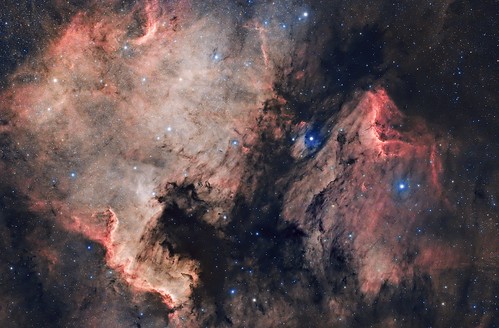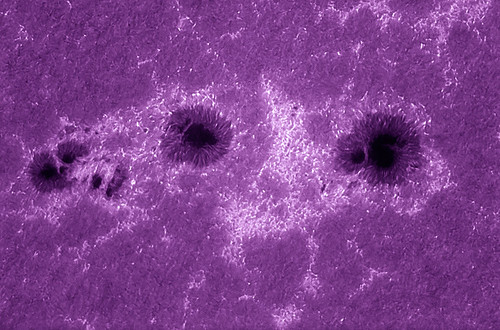Submissions: 2017 May
Re: Submissions: 2017 May
NGC 3718, 3729, and Hickson Group 56
Copyrights: Phil Keyser M51 Whirlpool Galaxy
Copyrights: Kerry-Ann Lecky Hepburn Stargazing
Copyrights: Daniel Coyle Markarian's Chain
Copyrights: Dan Meek Lagoon Nebula
Copyrights: Tolga Gumusayak and Mike Selby M51 - The Whirlpool Galaxy
Copyrights: Bernard Miller Orion
Copyrights: Mohammad Bagher Mireskandari Ancient Ground, Modern Sky
Copyrights: Amirreza Kamkar Milky Way over Nuclear Silos
Copyrights: Steven Crowley M31 - The Andromeda Galaxy
Copyrights: Oliver Czernetz
Full size: http://www.astrobin.com/294617/ Heiligenscein
Copyrights: Marco Meniero Conjunction of Moon and Jupiter
Copyrights: Marco Meniero Rho Ophuchi
Copyrights: Adam Jesionkiewicz Center of the Milky Way over national monument inverted tulips
Copyrights: Ahmad Riahi Green Ray
Copyrights: Sergi Luque Paris
Copyrights: Tamas Ladanyi Milky Way over Monument Valley
Copyrights: John Vermette Iris of the Moon
Copyrights: Wolfgang Neszmerak (Wolfman) Nearby Red Dwarfs (May 2nd.)
Copyrights: Damian Peach M97 Owl Nebula
Copyrights: George Chatzifrantzis Jupiter & Moon Company
Copyrights: G. Chatzifrantzis Sun Halo
Copyrights: G&L Messier 1
Copyrights: Remi Lacasse M13 - The Great Globular Cluster in Hercules
Copyrights: Álvaro Ibáñez Pérez NGC4837
Copyrights: Melina T Moon and Jupiter Conjunction at Daylight
Copyrights: Mohsen Salahshoor Ch. Respecting the Night Sky – Milky Way above Cumeada Observatory, Dark Sky Alqueva
Copyrights: Miguel Claro
Copyrights: Phil Keyser M51 Whirlpool Galaxy
Copyrights: Kerry-Ann Lecky Hepburn Stargazing
Copyrights: Daniel Coyle Markarian's Chain
Copyrights: Dan Meek Lagoon Nebula
Copyrights: Tolga Gumusayak and Mike Selby M51 - The Whirlpool Galaxy
Copyrights: Bernard Miller Orion
Copyrights: Mohammad Bagher Mireskandari Ancient Ground, Modern Sky
Copyrights: Amirreza Kamkar Milky Way over Nuclear Silos
Copyrights: Steven Crowley M31 - The Andromeda Galaxy
Copyrights: Oliver Czernetz
Full size: http://www.astrobin.com/294617/ Heiligenscein
Copyrights: Marco Meniero Conjunction of Moon and Jupiter
Copyrights: Marco Meniero Rho Ophuchi
Copyrights: Adam Jesionkiewicz Center of the Milky Way over national monument inverted tulips
Copyrights: Ahmad Riahi Green Ray
Copyrights: Sergi Luque Paris
Copyrights: Tamas Ladanyi Milky Way over Monument Valley
Copyrights: John Vermette Iris of the Moon
Copyrights: Wolfgang Neszmerak (Wolfman) Nearby Red Dwarfs (May 2nd.)
Copyrights: Damian Peach M97 Owl Nebula
Copyrights: George Chatzifrantzis Jupiter & Moon Company
Copyrights: G. Chatzifrantzis Sun Halo
Copyrights: G&L Messier 1
Copyrights: Remi Lacasse M13 - The Great Globular Cluster in Hercules
Copyrights: Álvaro Ibáñez Pérez NGC4837
Copyrights: Melina T Moon and Jupiter Conjunction at Daylight
Copyrights: Mohsen Salahshoor Ch. Respecting the Night Sky – Milky Way above Cumeada Observatory, Dark Sky Alqueva
Copyrights: Miguel Claro
-
FrankSackenheim
- Ensign
- Posts: 11
- Joined: Wed Apr 25, 2012 9:20 am
SMC - Continuumsubtraction
Hello,
i gave a try on whats called continuumsubtraction. I´ve heard this term for the first time from british astrophotographer Paul Beskeen. The Idea is to subtract an image of a continous spectrum from a narrowband image, to qualify the real narrowband emitter. This is a "Poor Men´s Method" as professional astronomers do it a little bit more complex (see papers on continuumsubtraction from science archives).
Well here is what i got. I present a RGB (OIIIHa) image as well as the continuum subtracted Ha and OIII Images, and an colormix of both oh them. Also i link an annotated image.
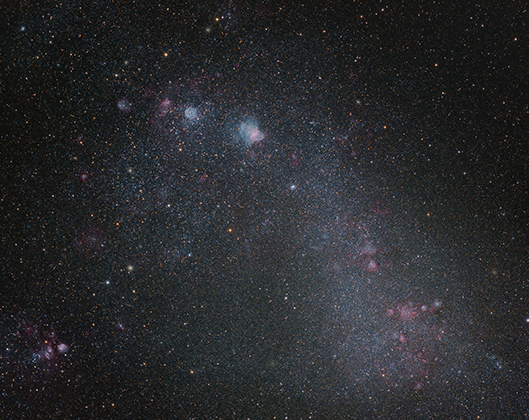
http://astrophotocologne.de/astrophotoc ... SMC_KS.jpg
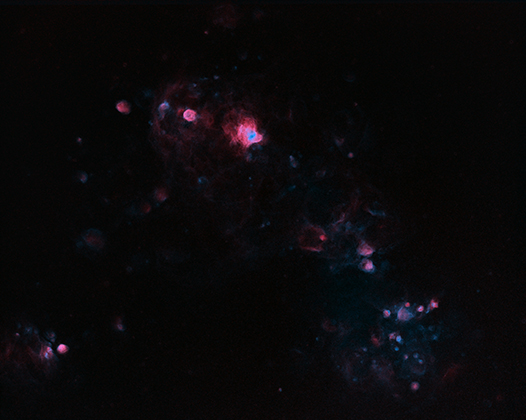
http://astrophotocologne.de/astrophotoc ... HaOIII.jpg

http://astrophotocologne.de/astrophotoc ... SMC_Ha.jpg
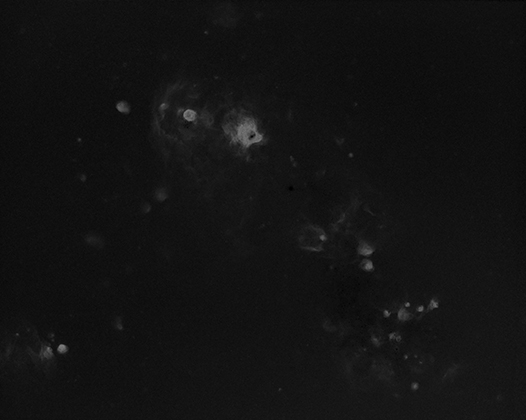
http://astrophotocologne.de/astrophotoc ... C_OIII.jpg

http://astrophotocologne.de/astrophotoc ... otated.jpg
Kiripotib Guestfarm Namibia
June/July 2016
Takahashi FSQ 106 ED
Moravian G3-16200
Vixen New Atlux an Tak EM200
Ha 6000 s
OIII 10800 s
RGB 3600 s each
CS Frank
i gave a try on whats called continuumsubtraction. I´ve heard this term for the first time from british astrophotographer Paul Beskeen. The Idea is to subtract an image of a continous spectrum from a narrowband image, to qualify the real narrowband emitter. This is a "Poor Men´s Method" as professional astronomers do it a little bit more complex (see papers on continuumsubtraction from science archives).
Well here is what i got. I present a RGB (OIIIHa) image as well as the continuum subtracted Ha and OIII Images, and an colormix of both oh them. Also i link an annotated image.

http://astrophotocologne.de/astrophotoc ... SMC_KS.jpg

http://astrophotocologne.de/astrophotoc ... HaOIII.jpg

http://astrophotocologne.de/astrophotoc ... SMC_Ha.jpg

http://astrophotocologne.de/astrophotoc ... C_OIII.jpg

http://astrophotocologne.de/astrophotoc ... otated.jpg
Kiripotib Guestfarm Namibia
June/July 2016
Takahashi FSQ 106 ED
Moravian G3-16200
Vixen New Atlux an Tak EM200
Ha 6000 s
OIII 10800 s
RGB 3600 s each
CS Frank
Re: Submissions: 2017 May
Optical corona around Jupiter
Copyright: Petr Horálek
More info and the image in higher resolution: http://www.astronom.cz/horalek/?p=3060
Copyright: Petr Horálek
More info and the image in higher resolution: http://www.astronom.cz/horalek/?p=3060
Re: Submissions: 2017 May
Jupiter and five moons
Copyright: Petr Horálek
More info and the image in higher resolution: http://www.astronom.cz/horalek/?p=3048
Copyright: Petr Horálek
More info and the image in higher resolution: http://www.astronom.cz/horalek/?p=3048
-
j.s.ebersole@gmail.com
Re: Submissions: 2017 May
M17
http://jebersol.zenfolio.com/
Copyright: John Ebersole The complex ionic structure of M17 is nicely detailed in this narrowband image in HST palette.
http://jebersol.zenfolio.com/
Copyright: John Ebersole The complex ionic structure of M17 is nicely detailed in this narrowband image in HST palette.
-
AstroScience
- Ensign
- Posts: 29
- Joined: Tue May 21, 2013 3:36 pm
Re: Submissions: 2017 May
NGC3718. NGC3729, Hickson 56 Group
Copyright: Sergio Kaminsky
16 Hours deep field of those peculiar galaxies from Negev Desert.
http://www.myastroscience.com/ngc3718
Copyright: Sergio Kaminsky
16 Hours deep field of those peculiar galaxies from Negev Desert.
http://www.myastroscience.com/ngc3718
-
Deep-Sky-Astroteam
- Ensign
- Posts: 54
- Joined: Tue Aug 26, 2014 9:01 am
- Location: Berlin - Germany
- Contact:
Re: Submissions: 2017 May
IC 417 The Spyder and The Fly
Copyright: Jens Zippel & Frank Iwaszkiewicz https://www.deep-sky-astroteam.de/en/ic ... -and-fly-0
Copyright: Jens Zippel & Frank Iwaszkiewicz https://www.deep-sky-astroteam.de/en/ic ... -and-fly-0
Re: Submissions: 2017 May
Moon and Jupiter
Copyrights: Divyadarshan Purohit Milky Way over the Great Wall of China
Copyrights: Steed Yu & NightChina.net Night sky over Greece
Copyrights: Petros Kaznesis Persistent Trail of a Lyrid Fireball
Copyrights: Guillaume Doyen Jupiter, GRS, and 3 moons 05-07-2017
Copyrights: John Chumack Gamma Cygnus Nebula
Copyrights: Eric Coles An Edge-on Galaxy
Copyrights: Wei-Hao Wang
Largier size: https://www.flickr.com/photos/weihaowan ... ateposted/ Jupiter and 5 moons
Copyrights: Petr Horálek Moon and Jupiter conjunction
Copyrights: Alireza Sadeghi The Sun
Copyrights: Daniel Baraldés Milky Way
Copyrights: Sarang Shah LMC and SMC
Copyrights: Sarang Shah Milky way in San Quirico d ‘Orcia, Tuscany, Italy
Copyrights: Luca Monteleone Jupiter and Moon Conjunction
Copyrights: Mohammad Reza Rastin Planetary Alignment in May 2002, 15 years ago
Copyrights: Len DiPinto Conjunction of Moon and Jupiter
Copyrights: Francisco Soldán
Copyrights: Divyadarshan Purohit Milky Way over the Great Wall of China
Copyrights: Steed Yu & NightChina.net Night sky over Greece
Copyrights: Petros Kaznesis Persistent Trail of a Lyrid Fireball
Copyrights: Guillaume Doyen Jupiter, GRS, and 3 moons 05-07-2017
Copyrights: John Chumack Gamma Cygnus Nebula
Copyrights: Eric Coles An Edge-on Galaxy
Copyrights: Wei-Hao Wang
Largier size: https://www.flickr.com/photos/weihaowan ... ateposted/ Jupiter and 5 moons
Copyrights: Petr Horálek Moon and Jupiter conjunction
Copyrights: Alireza Sadeghi The Sun
Copyrights: Daniel Baraldés Milky Way
Copyrights: Sarang Shah LMC and SMC
Copyrights: Sarang Shah Milky way in San Quirico d ‘Orcia, Tuscany, Italy
Copyrights: Luca Monteleone Jupiter and Moon Conjunction
Copyrights: Mohammad Reza Rastin Planetary Alignment in May 2002, 15 years ago
Copyrights: Len DiPinto Conjunction of Moon and Jupiter
Copyrights: Francisco Soldán
-
astrosirius
- Science Officer
- Posts: 117
- Joined: Fri Nov 23, 2012 11:17 am
- Location: Barcelona Spain
- Contact:
Re: Submissions: 2017 May
SPIRAL GALAXY M106
M106 also known as NGC4258 Is a galaxy in the constellation Canes Venatici. It is about 25 million light years away, and approximately 130,000 light years across. The unusual central glow makes M106 one of the closest examples of the Seyfert class of galaxies where vast amounts of glowing gas are thought to be falling into a central massive black hole.
M106 has a water vapor megamaser (the equivalent of a laser operating in microwave instead of visible light and on a galactic scale) that is seen by the 22-GHz line of ortho-H2O that evidences dense and warm molecular gas.
It is one of the largest and brightest nearby galaxies, similar in size and luminosity to the Andromeda Galaxy.
M106 has also played an important role in calibrating the cosmic distance ladder. Before, Cepheid variables from other galaxies cannot be used to measure distances since they cover ranges of metallicities different from the Milky Way's.
Copyright: Lluis Romero
http://astrophotographysirius.com/
M106 also known as NGC4258 Is a galaxy in the constellation Canes Venatici. It is about 25 million light years away, and approximately 130,000 light years across. The unusual central glow makes M106 one of the closest examples of the Seyfert class of galaxies where vast amounts of glowing gas are thought to be falling into a central massive black hole.
M106 has a water vapor megamaser (the equivalent of a laser operating in microwave instead of visible light and on a galactic scale) that is seen by the 22-GHz line of ortho-H2O that evidences dense and warm molecular gas.
It is one of the largest and brightest nearby galaxies, similar in size and luminosity to the Andromeda Galaxy.
M106 has also played an important role in calibrating the cosmic distance ladder. Before, Cepheid variables from other galaxies cannot be used to measure distances since they cover ranges of metallicities different from the Milky Way's.
Copyright: Lluis Romero
http://astrophotographysirius.com/
Lluís Romero Ventura
http://astrotolva.com/
http://astrotolva.com/
- moonrocks
- Science Officer
- Posts: 119
- Joined: Tue Jun 30, 2015 6:50 pm
- Location: spain, valencia
- Contact:
Re: Submissions: 2017 May
M101: The Pinwheel Galaxy - reminiscent of Fibonacci's sequence, the Golden Ratio.
Image here: http://moonrocksastro.com/wp-content/up ... axy-25.jpg
Copyright: Paul C. Swift
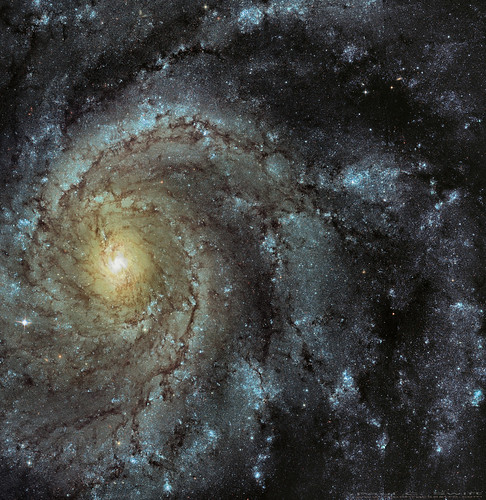 M101: The Pinwheel Galaxy by Paul C. Swift, on Flickr
M101: The Pinwheel Galaxy by Paul C. Swift, on Flickr
Image here: http://moonrocksastro.com/wp-content/up ... axy-25.jpg
Copyright: Paul C. Swift
 M101: The Pinwheel Galaxy by Paul C. Swift, on Flickr
M101: The Pinwheel Galaxy by Paul C. Swift, on FlickrRe: Submissions: 2017 May
Center
The image shows the central part of the Galaxy. The brightest part of the Milky Way sandwiched between the constellations of Scorpio, Sagittarius and Ophiuchus. Here is the highest concentration of stars and dust clouds. We can also see a lot of red hydrogen nebulae.
Canon 550Da + 24-105L, 24mm, f/4, iso 1600, 2 min.
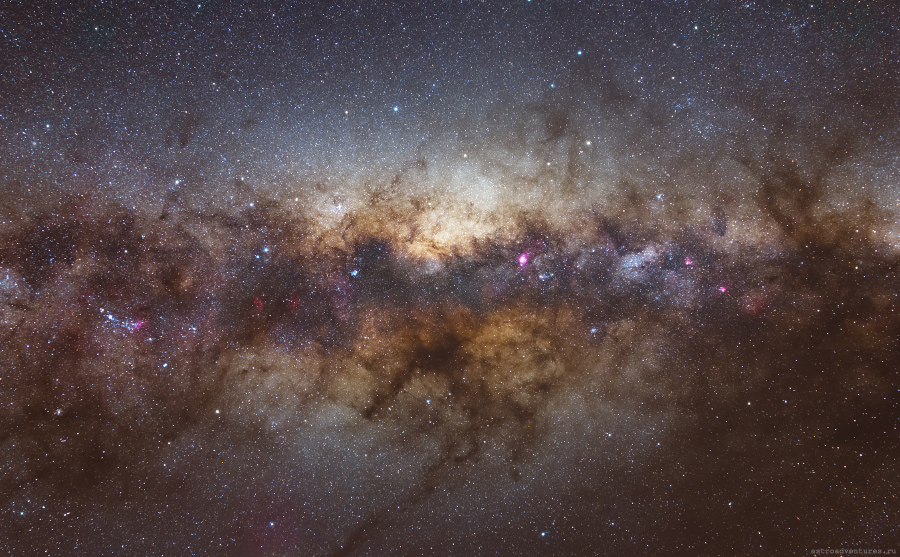
Author's site: http://www.astroadventures.ru/
Copyright: Yuri Zvezdny
The image shows the central part of the Galaxy. The brightest part of the Milky Way sandwiched between the constellations of Scorpio, Sagittarius and Ophiuchus. Here is the highest concentration of stars and dust clouds. We can also see a lot of red hydrogen nebulae.
Canon 550Da + 24-105L, 24mm, f/4, iso 1600, 2 min.

Author's site: http://www.astroadventures.ru/
Copyright: Yuri Zvezdny
-
ashtree
- Ensign
- Posts: 14
- Joined: Thu May 06, 2010 11:53 pm
- AKA: Adam_Jesion
- Location: Warsaw / Poland
- Contact:
Re: Submissions: 2017 May
The Great Eruption in the constellation of Carina
http://www.facebook.com/astrofotografia
Copyright: Adam Jesionkiewicz Hi resolution version is here:
http://astropolis.pl/gallery/NGC3372-Et ... lor_HF.jpg
Description:
In 1827 Burchell specifically noted Eta Carinae's unusual brightness at 1st magnitude, and was the first to suspect that it varied in brightness. John Herschel made a detailed series of accurate measurements in the 1830s showing that Eta Carinae consistently shone around magnitude 1.4 until November 1837. On the evening of December 16, 1837, Herschel was astonished to see that it had brightened to slightly outshine Rigel. This event marked the beginning of a roughly 18-year period known as the Great Eruption.
Eta Carinae is probably the greatest treasure of the southern sky. It is also the first object on which you will direct your telescopes if you want to admire its beauty. Moreover, to see the surrounding nebula, you do not really need anything. Under good conditions it is visible to the naked eye.
A star, located 7,700 light-years from Earth, is actually a stellar system composed of at least two components. Their mutually reinforced glow is millions of times brighter than our Sun, and is primarily responsible for lighting up the surrounding matter. It is finally one of the most beautiful nebulas you can observe. It's called Carina. Like other objects of this type, it is a active star-forming region.
It is difficult to find in the sky a more diverse object to observe. You will find reflection, emission, dark, dust, and other nebulae in it. All this you can see on my photo taken in the multi-spectral technique (gathering light emitted by ionized gases: oxygen, hydrogen and sulfur).
This picture cost me a lot. 12 thousand kilometers and 72 hours of travel. 3 nights struggle to collect photons. 15 hours of raw material processing. The result is a photograph that I undoubtedly point to as the groundbreaking and best astrophotography of my decade-long career. In this field, achieving the level of the image we dreamed up is extremely difficult. This time I have the impression that I look at the picture exactly what I wanted to do.
When working with narrowband filters, then trying to balance them in a graphical application, is such a magical moment when the monochrome picture blossoms with a color gamut. This is the moment in which the author himself cannot admire the scale of beauty of cosmic creation. Because we do not create it. Modestly we only record and interpret.
The work, however, is not ours.
http://www.facebook.com/astrofotografia
Copyright: Adam Jesionkiewicz Hi resolution version is here:
http://astropolis.pl/gallery/NGC3372-Et ... lor_HF.jpg
Description:
In 1827 Burchell specifically noted Eta Carinae's unusual brightness at 1st magnitude, and was the first to suspect that it varied in brightness. John Herschel made a detailed series of accurate measurements in the 1830s showing that Eta Carinae consistently shone around magnitude 1.4 until November 1837. On the evening of December 16, 1837, Herschel was astonished to see that it had brightened to slightly outshine Rigel. This event marked the beginning of a roughly 18-year period known as the Great Eruption.
Eta Carinae is probably the greatest treasure of the southern sky. It is also the first object on which you will direct your telescopes if you want to admire its beauty. Moreover, to see the surrounding nebula, you do not really need anything. Under good conditions it is visible to the naked eye.
A star, located 7,700 light-years from Earth, is actually a stellar system composed of at least two components. Their mutually reinforced glow is millions of times brighter than our Sun, and is primarily responsible for lighting up the surrounding matter. It is finally one of the most beautiful nebulas you can observe. It's called Carina. Like other objects of this type, it is a active star-forming region.
It is difficult to find in the sky a more diverse object to observe. You will find reflection, emission, dark, dust, and other nebulae in it. All this you can see on my photo taken in the multi-spectral technique (gathering light emitted by ionized gases: oxygen, hydrogen and sulfur).
This picture cost me a lot. 12 thousand kilometers and 72 hours of travel. 3 nights struggle to collect photons. 15 hours of raw material processing. The result is a photograph that I undoubtedly point to as the groundbreaking and best astrophotography of my decade-long career. In this field, achieving the level of the image we dreamed up is extremely difficult. This time I have the impression that I look at the picture exactly what I wanted to do.
When working with narrowband filters, then trying to balance them in a graphical application, is such a magical moment when the monochrome picture blossoms with a color gamut. This is the moment in which the author himself cannot admire the scale of beauty of cosmic creation. Because we do not create it. Modestly we only record and interpret.
The work, however, is not ours.
Re: Submissions: 2017 May
M106
Copyrights: Jerry Keith VdB 152 - Wolf"s Cave
Copyrights: Bob Franke
Larger size: http://bf-astro.com/APOD/VdB152big.jpg Crater Posidonius
Copyrights: Francesco Badalotti Heart Nebula
Copyrights: Jean M Dean
Larger size: https://www.astrobin.com/295037/?nc=user Clavius Crater Close-up
Copyrights: John Chumack Starburst Galaxy M82
Copyrights: Steve Cooper M81, M82, NGC3077 and IFN
Credits and Copyrights: Data: R. Colombari / C. Iaffaldano; Processing: R. Colombari
Full size: http://www.astrobin.com/full/295084/0/?nc=&real=&mod= Startrails
Copyrights: Ewa Zegler-Poleska 22 Degree Sun Halo Near Shiraz, Iran
Copyrights: Amir Shahcheraghian Iris
Copyrights: Raul Villaverde Fraile Hand of the Desert
Copyrights: Carlos Eduardo Fairbairn Messier 81 & Messier 82 with the Integrated Flux Nebulae
Copyrights: Rafael Schmall Winter nebula season is almost over
Copyrights: Steve Cannistra Jupiter's corona
Copyrights: Petr Horálek Eta Carinae Nebula
Copyrights: Samuel Müller Rho Ophiuchi could complex
Copyrights: Samuel Müller Moon and Jupiter
Copyrights: Ian Timberlake Lago Atitlán, under a young Milky Way
Copyrights: Sergio Montúfar Ara SNR
Copyrights: Dieter Willasch Crazed Earth
Copyrights: Steve Cullen The Moon and a passerby
Copyrights: Michael Doherty Full Moon rising next to Adolfturm in Friedberg
Copyrights: Ulrich Beinert
Copyrights: Jerry Keith VdB 152 - Wolf"s Cave
Copyrights: Bob Franke
Larger size: http://bf-astro.com/APOD/VdB152big.jpg Crater Posidonius
Copyrights: Francesco Badalotti Heart Nebula
Copyrights: Jean M Dean
Larger size: https://www.astrobin.com/295037/?nc=user Clavius Crater Close-up
Copyrights: John Chumack Starburst Galaxy M82
Copyrights: Steve Cooper M81, M82, NGC3077 and IFN
Credits and Copyrights: Data: R. Colombari / C. Iaffaldano; Processing: R. Colombari
Full size: http://www.astrobin.com/full/295084/0/?nc=&real=&mod= Startrails
Copyrights: Ewa Zegler-Poleska 22 Degree Sun Halo Near Shiraz, Iran
Copyrights: Amir Shahcheraghian Iris
Copyrights: Raul Villaverde Fraile Hand of the Desert
Copyrights: Carlos Eduardo Fairbairn Messier 81 & Messier 82 with the Integrated Flux Nebulae
Copyrights: Rafael Schmall Winter nebula season is almost over
Copyrights: Steve Cannistra Jupiter's corona
Copyrights: Petr Horálek Eta Carinae Nebula
Copyrights: Samuel Müller Rho Ophiuchi could complex
Copyrights: Samuel Müller Moon and Jupiter
Copyrights: Ian Timberlake Lago Atitlán, under a young Milky Way
Copyrights: Sergio Montúfar Ara SNR
Copyrights: Dieter Willasch Crazed Earth
Copyrights: Steve Cullen The Moon and a passerby
Copyrights: Michael Doherty Full Moon rising next to Adolfturm in Friedberg
Copyrights: Ulrich Beinert
-
Ian Regan
Re: Submissions: 2017 May
Cassini's "Grand Finale" Saturn Portrait (April 13, 2017)
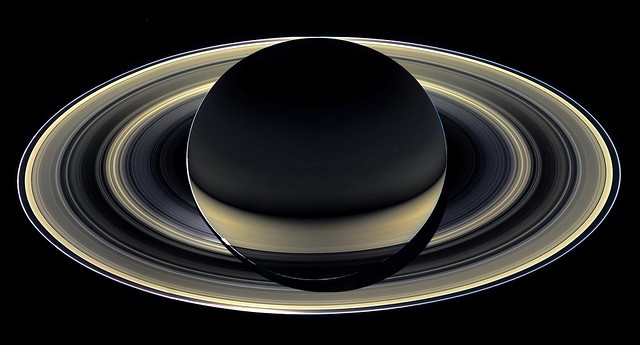
Cassini's "Grand Finale" Saturn Portrait (April 13, 2017) Ian Regan
In the early hours of April 13, 2017, a veteran NASA probe captured this breathtaking and unique visage of the Saturnian system as it coasted through space in the shadow of the gas giant.
Using its Wide-Angle Camera (part of the Imaging Science Subsystem), Cassini snapped 96 individual digital photos: these images consisted of Red, Green, and Blue-filtered frames, covering a total of 32 ‘footprints’. These 32 color frames were painstakingly combined to produce the final mosaic.
The veteran spacecraft took nearly four hours to collect these data. In that time, Cassini was slowly cruising away from the planet, en route to apoapse (the point farthest from Saturn in any given orbit) of Revolution 269. The distance to the planet increased by 82,000 km in that time, and in the end, the distance to the cloud-tops equalled 650,040 km.
All components of the main ring system are visible, seen here illuminated from behind: a vantage point technically known as a ‘high-phase angle’. In this geometry, a peculiar reversal happens: the thinner and more translucent rings shine out brightly, while the more opaque and thicker regions are relatively dark.
Only two moons — Janus and Mimas — can be picked out in this uncalibrated and compressed data, in addition to a red-giant star in the constellation of Gemini: Tejat (μ Gem).
________________________________
Credit: NASA/JPL/Caltech/SSI/Ian Regan

Cassini's "Grand Finale" Saturn Portrait (April 13, 2017) Ian Regan
In the early hours of April 13, 2017, a veteran NASA probe captured this breathtaking and unique visage of the Saturnian system as it coasted through space in the shadow of the gas giant.
Using its Wide-Angle Camera (part of the Imaging Science Subsystem), Cassini snapped 96 individual digital photos: these images consisted of Red, Green, and Blue-filtered frames, covering a total of 32 ‘footprints’. These 32 color frames were painstakingly combined to produce the final mosaic.
The veteran spacecraft took nearly four hours to collect these data. In that time, Cassini was slowly cruising away from the planet, en route to apoapse (the point farthest from Saturn in any given orbit) of Revolution 269. The distance to the planet increased by 82,000 km in that time, and in the end, the distance to the cloud-tops equalled 650,040 km.
All components of the main ring system are visible, seen here illuminated from behind: a vantage point technically known as a ‘high-phase angle’. In this geometry, a peculiar reversal happens: the thinner and more translucent rings shine out brightly, while the more opaque and thicker regions are relatively dark.
Only two moons — Janus and Mimas — can be picked out in this uncalibrated and compressed data, in addition to a red-giant star in the constellation of Gemini: Tejat (μ Gem).
________________________________
Credit: NASA/JPL/Caltech/SSI/Ian Regan
Re: Submissions: 2017 May
Zodiacal Light Over Horseshoe Bend
Copyrights: Dave Lane The Galaxy and the Keck Dome
Copyrights: Jiajie Zhang Milky Way
Copyrights: Mahdi Alinejad Driving across 'The Bay of Rainbows'
Copyrights: John Chumack A Solar Eclipse on the Moon (Artist impression)
Copyrights: Andrew Bodrov The Moon
Copyrights: Noëlle Drtil The Sun exhales, A perspective
Copyrights: Barry Riu The colorful Rho Ophiuchi region
Credits and Copyrights: Data: DSS-2, R. Colombari; Assembling and processing: R. Colombari
Full size: http://www.astrobin.com/full/295291/0/?nc=&real=&mod= NGC 2070 Tarantula Nebula
Copyrights: Francesco Badalotti Buddha Purnima Moon /Full Moon Sets over Delhi
Copyrights: Abhinav Singhai The Eta Carina Nebula
Copyrights: Haim Huli
Larger size: https://www.flickr.com/photos/101543943 ... ateposted/ IC 434
Copyrights: Domingo Pestana, Nicolás Romo and Raúl Villaverde Rho Ophiuchi
Copyrights: Leonardo Ciuffolotti, Matteo Collina, Riccardo De Benedictis, Giuseppe Donatiello and Rolando Ligustri C/2015 ER61(PanSTARRS) on May 9th
Copyrights: Damian Peach Star trails and Siding Spring comet from Australia
Copyrights: Christian Sasse Flower Moon with a wild photographer
Copyrights: Alyn Wallace The Creature in the Clouds of Southern Skies
Copyrights: Adam Jesionkiewicz ISS and Moon
Copyrights: Dani Caxete From Vela to Centaurus
Copyrights: Mario Cogo NGC 3324
Copyrights: Mario Cogo
Copyrights: Dave Lane The Galaxy and the Keck Dome
Copyrights: Jiajie Zhang Milky Way
Copyrights: Mahdi Alinejad Driving across 'The Bay of Rainbows'
Copyrights: John Chumack A Solar Eclipse on the Moon (Artist impression)
Copyrights: Andrew Bodrov The Moon
Copyrights: Noëlle Drtil The Sun exhales, A perspective
Copyrights: Barry Riu The colorful Rho Ophiuchi region
Credits and Copyrights: Data: DSS-2, R. Colombari; Assembling and processing: R. Colombari
Full size: http://www.astrobin.com/full/295291/0/?nc=&real=&mod= NGC 2070 Tarantula Nebula
Copyrights: Francesco Badalotti Buddha Purnima Moon /Full Moon Sets over Delhi
Copyrights: Abhinav Singhai The Eta Carina Nebula
Copyrights: Haim Huli
Larger size: https://www.flickr.com/photos/101543943 ... ateposted/ IC 434
Copyrights: Domingo Pestana, Nicolás Romo and Raúl Villaverde Rho Ophiuchi
Copyrights: Leonardo Ciuffolotti, Matteo Collina, Riccardo De Benedictis, Giuseppe Donatiello and Rolando Ligustri C/2015 ER61(PanSTARRS) on May 9th
Copyrights: Damian Peach Star trails and Siding Spring comet from Australia
Copyrights: Christian Sasse Flower Moon with a wild photographer
Copyrights: Alyn Wallace The Creature in the Clouds of Southern Skies
Copyrights: Adam Jesionkiewicz ISS and Moon
Copyrights: Dani Caxete From Vela to Centaurus
Copyrights: Mario Cogo NGC 3324
Copyrights: Mario Cogo
Re: Submissions: 2017 May
The zodiacal light and winter Milky Way
Copyrights: Derrick Lim Rosette
Copyrights: Rafael Rodríguez Rosette Nebula
Copyrights: Steven Mohr NGC 7742, a galaxy in the constellation Pegasus
Credits and Copyrights: Data: Hubble Legacy Archive; Processing: Gregorio Montero Gil Herbig Haro
Copyrights: Sara Wager NGC 7000 and NGc 5070
Copyrights: Raul Villaverde Fraile More water than earth
Copyrights: Sergio Galán Storm flashers
Copyrights: Sergio Galán A non conventional star trail
Copyrights: Christian Cammoraensi Moonrise
Copyrights: Klaus Rübke Many faces of Saturn
Copyrights: Ian Griffin Pareidolia
Copyrights: José Ramos Half of the Moon and Lunar X in a Craters Show
Copyrights: Miguel Claro C/2015 V2 (Johnson) on May 1st
Copyrights: Damian Peach Milky Way over the church
Copyrights: Jorgelina Alvarez NGC 7635
Copyrights: Geoffrey Graham
Copyrights: Derrick Lim Rosette
Copyrights: Rafael Rodríguez Rosette Nebula
Copyrights: Steven Mohr NGC 7742, a galaxy in the constellation Pegasus
Credits and Copyrights: Data: Hubble Legacy Archive; Processing: Gregorio Montero Gil Herbig Haro
Copyrights: Sara Wager NGC 7000 and NGc 5070
Copyrights: Raul Villaverde Fraile More water than earth
Copyrights: Sergio Galán Storm flashers
Copyrights: Sergio Galán A non conventional star trail
Copyrights: Christian Cammoraensi Moonrise
Copyrights: Klaus Rübke Many faces of Saturn
Copyrights: Ian Griffin Pareidolia
Copyrights: José Ramos Half of the Moon and Lunar X in a Craters Show
Copyrights: Miguel Claro C/2015 V2 (Johnson) on May 1st
Copyrights: Damian Peach Milky Way over the church
Copyrights: Jorgelina Alvarez NGC 7635
Copyrights: Geoffrey Graham
-
tommy_nawratil
- Ensign
- Posts: 28
- Joined: Sat Aug 24, 2013 8:43 pm
- Location: Vienna, Austria
- Contact:
Re: Submissions: 2017 May
a sunflower galaxy M63 with good depth, taken from suburban sky near Vienna.
Moravian G2-8300 and 10" f/4 Lacerta photonewton

for full size and data please visit
http://www.astrobin.com/295458/
clear skies, Tommy
Moravian G2-8300 and 10" f/4 Lacerta photonewton

for full size and data please visit
http://www.astrobin.com/295458/
clear skies, Tommy
Re: Submissions: 2017 May
RCW89 and SuperNova Remnant
Copyrights: Don Goldman
Full size: http://astrodonimaging.com/gallery/rcw89-in-circinus/ Jupiter and Galileian moons
Copyrights: Bijan Moravej Lyrids Meteor Shower & startrail
Copyrights: Bijan Moravej The Saturn Family Portrait
Copyrights: John Chumack Jupiter and its moons on 16/05
Copyrights: John Chumack Small and Large Magellanic Clouds, with an inactive volcano inbetween
Copyrights: Carlos Eduardo Fairbairn The Great Eruption in the constellation of Carina
Copyrights: Adam Jesionkiewicz Galaxy Cluster ESO 146-5
Credits and Copyrights: Data: Hubble Legacy Archive; Processing: Domingo Pestana Moon-Jupiter, 7th May
Copyrights: Francisco José Sevilla Variable Winds on Hot Giant Exoplanet Help Study of Magnetic Field
Image credits: PSI
An article: Variable Winds on Hot Giant Exoplanet H ... etic Field IC 1396 - Elephant trunk nebula
Copyrights: Justin Daniel Recent Singapore Airlines Lunar Transit
Copyrights: Michael Marston Comet C/2015 ER61 PANSTARRS after outburst
Copyrights: José J. Chambó Moon close to Saturn on May 13th
Copyrights: Christian Koll Moonbow and stars at Yosemite Falls
Copyrights: Tony Rowell June Solstice
Copyrights: Raymond Brooks Red Moonrise composite
Copyrights: Laszlo Beinrohr
Copyrights: Don Goldman
Full size: http://astrodonimaging.com/gallery/rcw89-in-circinus/ Jupiter and Galileian moons
Copyrights: Bijan Moravej Lyrids Meteor Shower & startrail
Copyrights: Bijan Moravej The Saturn Family Portrait
Copyrights: John Chumack Jupiter and its moons on 16/05
Copyrights: John Chumack Small and Large Magellanic Clouds, with an inactive volcano inbetween
Copyrights: Carlos Eduardo Fairbairn The Great Eruption in the constellation of Carina
Copyrights: Adam Jesionkiewicz Galaxy Cluster ESO 146-5
Credits and Copyrights: Data: Hubble Legacy Archive; Processing: Domingo Pestana Moon-Jupiter, 7th May
Copyrights: Francisco José Sevilla Variable Winds on Hot Giant Exoplanet Help Study of Magnetic Field
Image credits: PSI
An article: Variable Winds on Hot Giant Exoplanet H ... etic Field IC 1396 - Elephant trunk nebula
Copyrights: Justin Daniel Recent Singapore Airlines Lunar Transit
Copyrights: Michael Marston Comet C/2015 ER61 PANSTARRS after outburst
Copyrights: José J. Chambó Moon close to Saturn on May 13th
Copyrights: Christian Koll Moonbow and stars at Yosemite Falls
Copyrights: Tony Rowell June Solstice
Copyrights: Raymond Brooks Red Moonrise composite
Copyrights: Laszlo Beinrohr
-
astronut2007
- Ensign
- Posts: 41
- Joined: Thu Feb 02, 2012 1:07 pm
Re: Submissions: 2017 May
Re: Submissions: 2017 May
The moon in colors shows us its minerals
Moon 16.05.2017 - Avellaneda - Argentina
© Carlos Di Nallo
http://carlosdn-alfacentauri.blogspot.com.ar/
© Carlos Di Nallo
http://carlosdn-alfacentauri.blogspot.com.ar/
Re: Submissions: 2017 May
Saturn 16.05.2017
Telescope: Maksutov 150/1800
Canon 6D + barlow 2x
Avellaneda - Argentina
© Carlos Di Nallo
http://carlosdn-alfacentauri.blogspot.com.ar/
Telescope: Maksutov 150/1800
Canon 6D + barlow 2x
Avellaneda - Argentina
© Carlos Di Nallo
http://carlosdn-alfacentauri.blogspot.com.ar/
Last edited by carlosdn on Fri May 19, 2017 2:20 am, edited 1 time in total.
Re: Submissions: 2017 May
Venus 17.05.2017
Telescope: maksutov 150/1800
Canon 6D + barlow2x
Avellaneda -Argentina
© Carlos Di Nallo
http://carlosdn-alfacentauri.blogspot.com.ar/
Telescope: maksutov 150/1800
Canon 6D + barlow2x
Avellaneda -Argentina
© Carlos Di Nallo
http://carlosdn-alfacentauri.blogspot.com.ar/
- Adrien Mauduit
- Ensign
- Posts: 81
- Joined: Thu Dec 15, 2016 10:58 pm
- Location: Tromsø, Norway
- Contact:
Re: Submissions: 2017 May
Capella rising
Credits: Adrien Mauduit
Capella, actually composed of four stars, situated in the Auriga constellation is the 3rd brightest star in the northern celestial hemisphere, and the 11th in the whole night sky. As the picture suggests, it rises just above the northern horizon at this time of year in Denmark. I took the shot at 2:30 am on May 18th 2017 on Høve beach in Odsherred, as we were transitioning from the astronomical dawn into the nautical dawn. As I was looking for a sign of noctilucent clouds, even the highest cirrus reflect some of the light emanating from the sunrise hundreds of km from there. Notice of they seem to make the night sky glowing and alive!
Canon 6D modded + Sigma 50mm f/1.4 Art @ f/2.8, 9 x 5'' @ ISO 800, PTGui Pro + Lr/Ps.
Credits: Adrien Mauduit
Capella, actually composed of four stars, situated in the Auriga constellation is the 3rd brightest star in the northern celestial hemisphere, and the 11th in the whole night sky. As the picture suggests, it rises just above the northern horizon at this time of year in Denmark. I took the shot at 2:30 am on May 18th 2017 on Høve beach in Odsherred, as we were transitioning from the astronomical dawn into the nautical dawn. As I was looking for a sign of noctilucent clouds, even the highest cirrus reflect some of the light emanating from the sunrise hundreds of km from there. Notice of they seem to make the night sky glowing and alive!
Canon 6D modded + Sigma 50mm f/1.4 Art @ f/2.8, 9 x 5'' @ ISO 800, PTGui Pro + Lr/Ps.
Adrien Louis Mauduit
M. Sc. in environmental sciences
Astrophotographer - cinematographer -
Aurora expert - Science communication & author
www.nightlightsfilms.com
nightlightsfilms@gmail.com
M. Sc. in environmental sciences
Astrophotographer - cinematographer -
Aurora expert - Science communication & author
www.nightlightsfilms.com
nightlightsfilms@gmail.com
